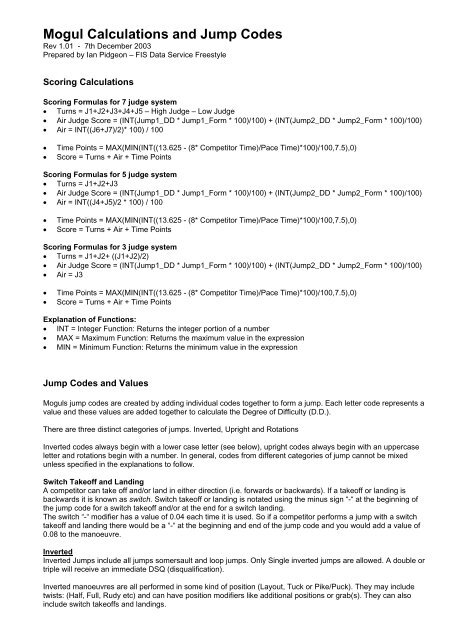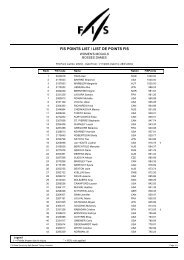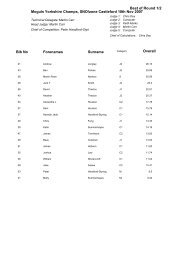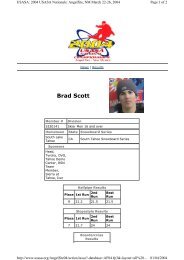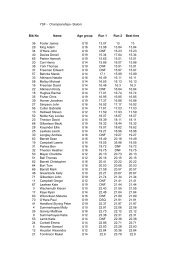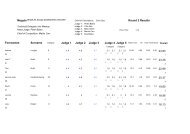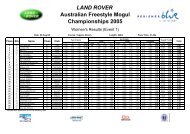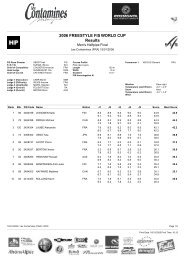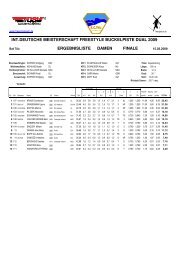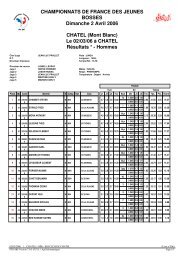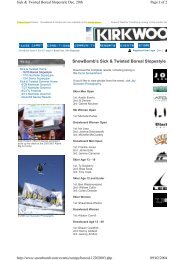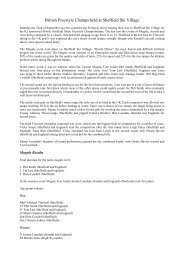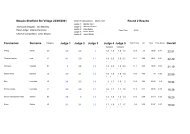AFP Judging Manual - Kent Freestyle
AFP Judging Manual - Kent Freestyle
AFP Judging Manual - Kent Freestyle
You also want an ePaper? Increase the reach of your titles
YUMPU automatically turns print PDFs into web optimized ePapers that Google loves.
Mogul Calculations and Jump Codes<br />
Rev 1.01 - 7th December 2003<br />
Prepared by Ian Pidgeon – FIS Data Service <strong>Freestyle</strong><br />
Scoring Calculations<br />
Scoring Formulas for 7 judge system<br />
• Turns = J1+J2+J3+J4+J5 – High Judge – Low Judge<br />
• Air Judge Score = (INT(Jump1_DD * Jump1_Form * 100)/100) + (INT(Jump2_DD * Jump2_Form * 100)/100)<br />
• Air = INT((J6+J7)/2)* 100) / 100<br />
• Time Points = MAX(MIN(INT((13.625 - (8* Competitor Time)/Pace Time)*100)/100,7.5),0)<br />
• Score = Turns + Air + Time Points<br />
Scoring Formulas for 5 judge system<br />
• Turns = J1+J2+J3<br />
• Air Judge Score = (INT(Jump1_DD * Jump1_Form * 100)/100) + (INT(Jump2_DD * Jump2_Form * 100)/100)<br />
• Air = INT((J4+J5)/2 * 100) / 100<br />
• Time Points = MAX(MIN(INT((13.625 - (8* Competitor Time)/Pace Time)*100)/100,7.5),0)<br />
• Score = Turns + Air + Time Points<br />
Scoring Formulas for 3 judge system<br />
• Turns = J1+J2+ ((J1+J2)/2)<br />
• Air Judge Score = (INT(Jump1_DD * Jump1_Form * 100)/100) + (INT(Jump2_DD * Jump2_Form * 100)/100)<br />
• Air = J3<br />
• Time Points = MAX(MIN(INT((13.625 - (8* Competitor Time)/Pace Time)*100)/100,7.5),0)<br />
• Score = Turns + Air + Time Points<br />
Explanation of Functions:<br />
• INT = Integer Function: Returns the integer portion of a number<br />
• MAX = Maximum Function: Returns the maximum value in the expression<br />
• MIN = Minimum Function: Returns the minimum value in the expression<br />
Jump Codes and Values<br />
Moguls jump codes are created by adding individual codes together to form a jump. Each letter code represents a<br />
value and these values are added together to calculate the Degree of Difficulty (D.D.).<br />
There are three distinct categories of jumps. Inverted, Upright and Rotations<br />
Inverted codes always begin with a lower case letter (see below), upright codes always begin with an uppercase<br />
letter and rotations begin with a number. In general, codes from different categories of jump cannot be mixed<br />
unless specified in the explanations to follow.<br />
Switch Takeoff and Landing<br />
A competitor can take off and/or land in either direction (i.e. forwards or backwards). If a takeoff or landing is<br />
backwards it is known as switch. Switch takeoff or landing is notated using the minus sign “-“ at the beginning of<br />
the jump code for a switch takeoff and/or at the end for a switch landing.<br />
The switch “-“ modifier has a value of 0.04 each time it is used. So if a competitor performs a jump with a switch<br />
takeoff and landing there would be a “-“ at the beginning and end of the jump code and you would add a value of<br />
0.08 to the manoeuvre.<br />
Inverted<br />
Inverted Jumps include all jumps somersault and loop jumps. Only Single inverted jumps are allowed. A double or<br />
triple will receive an immediate DSQ (disqualification).<br />
Inverted manoeuvres are all performed in some kind of position (Layout, Tuck or Pike/Puck). They may include<br />
twists: (Half, Full, Rudy etc) and can have position modifiers like additional positions or grab(s). They can also<br />
include switch takeoffs and landings.


